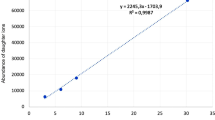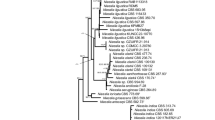Abstract
The production and metabolism of indole compounds in pure cultures of the ectendomycorrhizal strain MrgX, a common symbiont of Scots pine in forest nurseries, were investigated. Different indole compounds produced by this fungus were purified and identified by thin-layer chromatography, high-performance liquid chromatography and mass spectrometry. Indole-3-acetic acid (IAA) and indole-3-carboxylic acid were the most abundant. Although MrgX is able to synthesize IAA when cultivated on a medium without tryptophan, much higher IAA production was obtained when 1 mM tryptophan was added. Buffering of the medium at pH 5.8 was shown to be essential for IAA accumulation in the culture filtrate. In vitro IAA-synthesizing activity of the enzymes extracted from the mycelia of MrgX was also maximal when mycelia were grown in a buffered, tryptophan-supplemented medium. The hydrogen ion concentration strongly affected in vivo activity of IAA-synthesizing enzymes. This activity was rather weak at acid pH and was stimulated by increase in pH up to 8.5. These results and their possible significance for ectendo-mycorrhizal symbiosis are discussed with reference to the hormonal metabolism of ectomycorrhizal fungi and ectomycorrhizae.
Similar content being viewed by others
References
Danielson RM (1982) Taxonomic affinities and criteria for identification of the common ectendomycorrhizal symbiont of pines. Can J Bot 60:7–18
Durand N, Debaud JC, Casselton LA, Gay G (1992) Isolation and preliminary characterisation of 5-fluoroindole-resistant and IAA-overproducer mutants of the ectomycorrhizal fungus Hebeloma cylindrosporum Romagnesi. New Phytol (in press)
Ek M, Ljungquist PO, Stenström E (1983) Indole-3-acetic acid production by mycorrhizal fungi determined by gas-chromatography-mass spectrometry. New Phytol 94:401–407
Gay G (1986a) Effect of glucose on indole-3-acetic acid production by the ectomycorrhizal fungus Hebeloma hiemale in pure culture. Physiol Veg 24:185–192
Gay G (1986b) pH dependence of IAA release by an ectomycorrhizal fungus. In: Gianinazzi-Pearson V, Gianinazzi S (eds) Physiological and genetical aspects of mycorrhizae. INRA, Paris, pp 541–546
Gay G (1990) Effect of the ectomycorrhizal fungus Hebeloma hiemale on adventitious root formation by de-rooted Pinus halpensis shoot hypocotyls. Can J Bot 68:1265–1270
Gay G, Debaud JC (1987) Genetic study on indole-3-acetic acid production by ectomycorrhizal Hebeloma species: inter- and intraspecific variability in homo- and dicaryotic mycelia. Appl Microbiol Biotechnol 26:141–146
Gay G, Rouillon R, Bernillon J, Favre-Bonvin J (1989) IAA bio-synthesis by the ectomycorrhizal fungus Hebeloma hiemale as affected by different precursors. Can J Bot 67:2235–2239
Harley JL, Smith SE (1983) Mycorrhizal symbiosis. Academic Press, London New York
Horak E (1964) Die Bildung von IES Derivaten durch ectotrophe Mykorrhizapilze (Phlegmacium spp) von Picea abies Karsten. Phytopathol Z 51:491–515
Hung LL, Trappe JM (1983) Growth variation between and within species of ectomycorrhizal fungi in response to pH in vitro. Mycologia 75:234–241
Laiho O (1965) Further studies on the ectendotrophic mycorrhiza. Acta For Fenn 79:1–35
Laiho O (1986) Practical forestry needs more research on ectomy-corrhiza physiology in Finland. In: Gianinazzi-Pearson V, Gianinazzi S (eds) Physiological and genetical aspects of mycorrhizae. INRA, Paris, pp 489–492
Meyer FH (1974) Physiology of mycorrhiza. Annu Rev Plant Physiol 25:567–586
Mikola P (1965) Studies on the ectendotrophic mycorrhiza of pine. Acta For Fenn 79:2
Mikola (1988) The role of ectomycorrhiza in forest nurseries. Agric Ecosyst Environ 28:343–350
Moser M (1959) Beiträge zur Kenntnis der Wuchsstoffbeziehungen im Bereich ektotropher Mykorrhizen. Ark Mikrobiol 34:251–269
Moser M (1962) Die Bildung von Indol-Wuchsstoffen durch Mykorrhizapilze. Ber Dtsch Bot Ges 75:27–34
Mudge KW (1987) Hormonal involvement in ectomycorrhizal development. In: Sylvia DM, Hung LL, Graham HH (eds) Mycorrhizae in the next decade. Proceedings of the 7th North American Conference on Mycorrhizae. University of Florida, Gainesville, pp 228–230
Nylund JE (1988) The regulation of mycorrhiza formation — carbohydrate and hormone theories reviewed. Scand J For Res 3:465–479
Pachlewski R (1983) Symbiotic fungi and mycorrhiza of Scotch pine (Pinus sylvestris L.). Pr Inst Badaw Lesn 615:3–132
Pachlewski R, Kocon J (1985) Ultrastructure of the hyphae of ectendomycorrhizal fungus of Scotch pine. Acta Mycol 21:23–26
Pachlewski R, Pachlewska J (1971) Investigations on mycorrhizal fungi of seedlings of Scotch pine (Pinus sylvestris L.). Pr Inst Badaw Lesn 395:3–65
Piché Y, Ackerley CA, Peterson RL (1986) Structural characteristics of ectendomycorrhizas synthesized between roots of Pinus resinosa and the E-strain fungus, Wilcoxina mikolae var. mikolae. New Phytol 104:447–452
Pilet PE (1957) Dosage photocolorimétrique de l'acide β-indolyl acétique: application à l'étude des auxines-oxydases. Rev Gen Bot 64:106–122
Pilet PE (1961) Les phytohormones de croissance. Méthodes, chimie, biochimie, physiologie, applications pratiques. Masson, Paris
Pilet PE, Collet G (1962) Méthodes d'analyse du catabolisme auxinique. Zwahlen, Lausanne
Raven JA (1975) Transport of indoleacetic acid in plant cells in relation to pH and electrical potential gradients and its significance for polar IAA transport. New Phytol 74:163–172
Rouillon R, Gay G, Bernillon J, Favre-Bonvin J, Bruchet G (1986) Analysis by HPLC-mass spectrometry of the indole compounds released by the ectomycorrhizal fungus Hebeloma hiemale in pure culture. Can J Bot 64:1893–1897
Rubery PH (1980) The mechanism of transmembrane auxin transport and its relation to the chemiosmotic hypothesis of the polar transport of auxin. In: Skoog F (ed) Plant growth substances. Proceedings of the 10th International Conference on Plant Growth Substances, Madison, Wis 1979. Springer, Berlin Heidelberg New York, pp 50–60
Rubery PH, Sheldrake AR (1974) Carrier-mediated auxin transport. Planta 118:102–121
Rudawska M (1980) Effect of pine root extractives on growth regulators and IAA-oxidase activity in pure culture of mycorrhizal fungi. Acta Physiol Plant 2:133–144
Rudawska M (1983) The effect of nitrogen and phosphorus on auxin and cytokinin production by mycorrhizal fungi. Arbor Kórnickie 28:219–236
Rudawska M, Gay G (1989) IAA synthesizing activity of different ectomycorrhizal fungi in relation to nitrogen nutrition. Agric Ecosyst Environ 28:425–430
Slankis V (1973) Hormonal relationships in mycorrhizal development. In: Marks GC, Kozlowski TT (eds) Ectomycorrhizae. Academic Press, London New York, pp 231–298
Strzelczyk E (1975) Advances in microbiological research on rhizosphere of cultivated plants (in Polish). In: Toruń Scientific Society (ed) Z Dziejow Nauki Polskiej-Ksiega Pamiatkowa, pp 195–228
Strzelczyk E, Sitek JM, Kowalski S (1977) Synthesis of auxins from tryptophan and tryptophan precursor by fungi isolated from mycorrhizae of pine (Pinus sylvestris L.). Acta Microbiol Pol 26:255–264
Sylvia DM, Sinclair WA (1983) Phenolic compounds and resistance to fungal pathogens induced in primary roots of Douglasfir seedlings by the ectomycorrhizal fungus Laccaria laccata. Phytopathology 73:390–397
Thomas GW, Jackson RM (1982) Scanning electron microscopy of sheathing mycorrhizas of Sitka spruce. Trans Br Mycol Soc 79:31–39
Tomaszewski M (1974) Production of growth regulators by mycorrhizal fungi in pure cultures. In: Pachlewski R, Pachlewska J (eds) Studies on symbiotic properties of mycorrhizal fungi of pine (Pinus sylvestris L.) with the aid of the method of mycorrhizal synthesis in pure cultures on agar. Forest Research Institute, Warsaw, pp 73–78
Tomaszewski M, Wojciechowska B (1974) The role of growth regulators released by fungi in pine mycorrhizae. In: Carr DJ (ed) Plant growth substances. Hirokawa, Tokyo, pp 217–227
Ulrich JM (1960) Auxin production by mycorrhizal fungi. Physiol Plant 13:429–443
Unestam T, Stenström E (1989) A method for observing and manipulating roots and root associated fungi on plants growing in nonsterile substrates. Scand J For Res 4:51–58
Wallander H, Nylund JE, Sundberg B (1992) Ectomycorrhiza and nitrogen effects on root IAA: results contrary to current theory. Mycorrhiza 1:91–92
Wilcox HE (1971) Morphology of ectendomycorrhizae in Pinus resinosa. In: Mycorrhizae. Proceedings of the 1st North American Conference on Mycorrhizae. US Dep Agric For Serv Misc Publ 1189, pp 54–86
Wilcox HE, Wang CJK (1987) Ectomycorrhizal and ectendomy-corrhizal associations of Phialophora finlandia with Pinus resinosa, Picea rubens and Betula alleghaniensis. Can J For Res 17:976–990
Wilcox HE, Ganmore-Neumann R, Wang CJK (1974) Characteristics of two fungi producing ectendomycorrhizae in Pinus resinosa. Can J Bot 52:2279–2282
Yang CS, Korf RP (1985a) A monograph of the genus Tricharina and a new segregate genus, Wilcoxina (Pezizales). Mycotaxon 23:457–481
Yang CS, Korf RP (1985b) Ascorhizoctoria Gen. Nov. and Complexipes Emend., two genera for anamorphs of species assigned to Tricharina (Discomycetes). Mycotaxon 23:457–481
Yang CS, Wilcox HE (1984) An E-strain ectendomycorrhiza formed by a new species, Tricharina mikolae. Mycologia 76:675–684
Author information
Authors and Affiliations
Rights and permissions
About this article
Cite this article
Rudawska, M., Bernillon, J. & Gay, G. Indole compounds released by the ectendomycorrhizal fungal strain MrgX isolated from a pine nursery. Mycorrhiza 2, 17–23 (1992). https://doi.org/10.1007/BF00206279
Issue Date:
DOI: https://doi.org/10.1007/BF00206279




